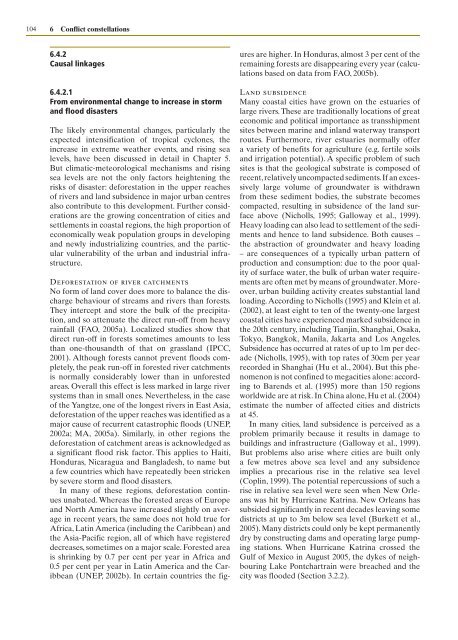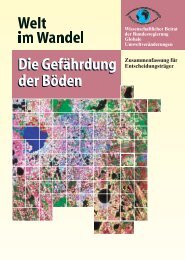World in Transition: Climate Change as a Security Risk - WBGU
World in Transition: Climate Change as a Security Risk - WBGU
World in Transition: Climate Change as a Security Risk - WBGU
You also want an ePaper? Increase the reach of your titles
YUMPU automatically turns print PDFs into web optimized ePapers that Google loves.
104<br />
6 Conflict constellations<br />
6.4.2<br />
Causal l<strong>in</strong>kages<br />
6.4.2.1<br />
From environmental change to <strong>in</strong>cre<strong>as</strong>e <strong>in</strong> storm<br />
and flood dis<strong>as</strong>ters<br />
The likely environmental changes, particularly the<br />
expected <strong>in</strong>tensification of tropical cyclones, the<br />
<strong>in</strong>cre<strong>as</strong>e <strong>in</strong> extreme weather events, and ris<strong>in</strong>g sea<br />
levels, have been discussed <strong>in</strong> detail <strong>in</strong> Chapter 5.<br />
But climatic-meteorological mechanisms and ris<strong>in</strong>g<br />
sea levels are not the only factors heighten<strong>in</strong>g the<br />
risks of dis<strong>as</strong>ter: deforestation <strong>in</strong> the upper reaches<br />
of rivers and land subsidence <strong>in</strong> major urban centres<br />
also contribute to this development. Further considerations<br />
are the grow<strong>in</strong>g concentration of cities and<br />
settlements <strong>in</strong> co<strong>as</strong>tal regions, the high proportion of<br />
economically weak population groups <strong>in</strong> develop<strong>in</strong>g<br />
and newly <strong>in</strong>dustrializ<strong>in</strong>g countries, and the particular<br />
vulnerability of the urban and <strong>in</strong>dustrial <strong>in</strong>fr<strong>as</strong>tructure.<br />
Deforestation of river catchments<br />
No form of land cover does more to balance the discharge<br />
behaviour of streams and rivers than forests.<br />
They <strong>in</strong>tercept and store the bulk of the precipitation,<br />
and so attenuate the direct run-off from heavy<br />
ra<strong>in</strong>fall (FAO, 2005a). Localized studies show that<br />
direct run-off <strong>in</strong> forests sometimes amounts to less<br />
than one-thousandth of that on gr<strong>as</strong>sland (IPCC,<br />
2001). Although forests cannot prevent floods completely,<br />
the peak run-off <strong>in</strong> forested river catchments<br />
is normally considerably lower than <strong>in</strong> unforested<br />
are<strong>as</strong>. Overall this effect is less marked <strong>in</strong> large river<br />
systems than <strong>in</strong> small ones. Nevertheless, <strong>in</strong> the c<strong>as</strong>e<br />
of the Yangtze, one of the longest rivers <strong>in</strong> E<strong>as</strong>t Asia,<br />
deforestation of the upper reaches w<strong>as</strong> identified <strong>as</strong> a<br />
major cause of recurrent cat<strong>as</strong>trophic floods (UNEP,<br />
2002a; MA, 2005a). Similarly, <strong>in</strong> other regions the<br />
deforestation of catchment are<strong>as</strong> is acknowledged <strong>as</strong><br />
a significant flood risk factor. This applies to Haiti,<br />
Hondur<strong>as</strong>, Nicaragua and Bangladesh, to name but<br />
a few countries which have repeatedly been stricken<br />
by severe storm and flood dis<strong>as</strong>ters.<br />
In many of these regions, deforestation cont<strong>in</strong>ues<br />
unabated. Where<strong>as</strong> the forested are<strong>as</strong> of Europe<br />
and North America have <strong>in</strong>cre<strong>as</strong>ed slightly on average<br />
<strong>in</strong> recent years, the same does not hold true for<br />
Africa, Lat<strong>in</strong> America (<strong>in</strong>clud<strong>in</strong>g the Caribbean) and<br />
the Asia-Pacific region, all of which have registered<br />
decre<strong>as</strong>es, sometimes on a major scale. Forested area<br />
is shr<strong>in</strong>k<strong>in</strong>g by 0.7 per cent per year <strong>in</strong> Africa and<br />
0.5 per cent per year <strong>in</strong> Lat<strong>in</strong> America and the Caribbean<br />
(UNEP, 2002b). In certa<strong>in</strong> countries the fig-<br />
ures are higher. In Hondur<strong>as</strong>, almost 3 per cent of the<br />
rema<strong>in</strong><strong>in</strong>g forests are disappear<strong>in</strong>g every year (calculations<br />
b<strong>as</strong>ed on data from FAO, 2005b).<br />
Land subsidence<br />
Many co<strong>as</strong>tal cities have grown on the estuaries of<br />
large rivers. These are traditionally locations of great<br />
economic and political importance <strong>as</strong> transshipment<br />
sites between mar<strong>in</strong>e and <strong>in</strong>land waterway transport<br />
routes. Furthermore, river estuaries normally offer<br />
a variety of benefits for agriculture (e.g. fertile soils<br />
and irrigation potential). A specific problem of such<br />
sites is that the geological substrate is composed of<br />
recent, relatively uncompacted sediments. If an excessively<br />
large volume of groundwater is withdrawn<br />
from these sediment bodies, the substrate becomes<br />
compacted, result<strong>in</strong>g <strong>in</strong> subsidence of the land surface<br />
above (Nicholls, 1995; Galloway et al., 1999).<br />
Heavy load<strong>in</strong>g can also lead to settlement of the sediments<br />
and hence to land subsidence. Both causes –<br />
the abstraction of groundwater and heavy load<strong>in</strong>g<br />
– are consequences of a typically urban pattern of<br />
production and consumption: due to the poor quality<br />
of surface water, the bulk of urban water requirements<br />
are often met by means of groundwater. Moreover,<br />
urban build<strong>in</strong>g activity creates substantial land<br />
load<strong>in</strong>g. Accord<strong>in</strong>g to Nicholls (1995) and Kle<strong>in</strong> et al.<br />
(2002), at le<strong>as</strong>t eight to ten of the twenty-one largest<br />
co<strong>as</strong>tal cities have experienced marked subsidence <strong>in</strong><br />
the 20th century, <strong>in</strong>clud<strong>in</strong>g Tianj<strong>in</strong>, Shanghai, Osaka,<br />
Tokyo, Bangkok, Manila, Jakarta and Los Angeles.<br />
Subsidence h<strong>as</strong> occurred at rates of up to 1m per decade<br />
(Nicholls, 1995), with top rates of 30cm per year<br />
recorded <strong>in</strong> Shanghai (Hu et al., 2004). But this phenomenon<br />
is not conf<strong>in</strong>ed to megacities alone: accord<strong>in</strong>g<br />
to Barends et al. (1995) more than 150 regions<br />
worldwide are at risk. In Ch<strong>in</strong>a alone, Hu et al. (2004)<br />
estimate the number of affected cities and districts<br />
at 45.<br />
In many cities, land subsidence is perceived <strong>as</strong> a<br />
problem primarily because it results <strong>in</strong> damage to<br />
build<strong>in</strong>gs and <strong>in</strong>fr<strong>as</strong>tructure (Galloway et al., 1999).<br />
But problems also arise where cities are built only<br />
a few metres above sea level and any subsidence<br />
implies a precarious rise <strong>in</strong> the relative sea level<br />
(Copl<strong>in</strong>, 1999). The potential repercussions of such a<br />
rise <strong>in</strong> relative sea level were seen when New Orleans<br />
w<strong>as</strong> hit by Hurricane Katr<strong>in</strong>a. New Orleans h<strong>as</strong><br />
subsided significantly <strong>in</strong> recent decades leav<strong>in</strong>g some<br />
districts at up to 3m below sea level (Burkett et al.,<br />
2005). Many districts could only be kept permanently<br />
dry by construct<strong>in</strong>g dams and operat<strong>in</strong>g large pump<strong>in</strong>g<br />
stations. When Hurricane Katr<strong>in</strong>a crossed the<br />
Gulf of Mexico <strong>in</strong> August 2005, the dykes of neighbour<strong>in</strong>g<br />
Lake Pontchartra<strong>in</strong> were breached and the<br />
city w<strong>as</strong> flooded (Section 3.2.2).
















